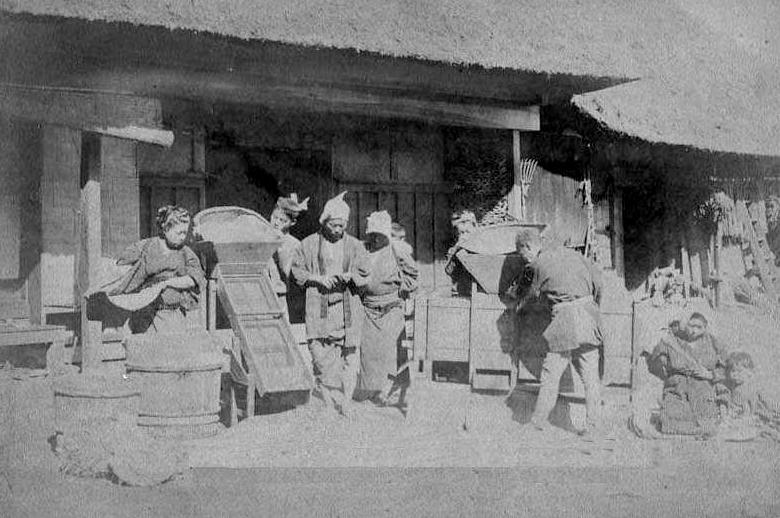
Figure 1.-- Here a Japanese peasant family is working on their rice crop, probably in the 1890s. |

|
When the Meiji Restoration began to modernize Japan, the stunning changes in the cities were not repeated in the countryside. In fact rural declined into a more feudal system. The major goal of the Meiji Government was to industrialize so Japan could could avoid Western colonial exploitation as experienced in China. To industrialize, Japan needed capital. To obtain capital, Meiji reformers had to turn to agriculture, the primary economic activity in the country. The Meiji government instituted land taxes to generate the capital needed for industrialization, The Land Tax Reform expanded landlordism (1873). The land of many peasant farmers was confiscated because they could not pay their taxes. Aristocratic land lords were thus able to expand their estates. The process was expanded by he deflationary Matsukata Fiscal Policy pursued (1881–85). This depressed rice prices, the primary cash crops causing more peasant bankruptcies. There were rural uprisings against the government, but were brutally suppressed. By the end of the Meiji Era, nearly 70 percent of peasant families descended into tenancy. Land during the Meiji Era became increasingly concentrated in the hands aristocratic landlords who acquired vast estates. The result was major inequities in Japanese society. Farm productivity as a result stagnated. Tenants commonly paid rents in kind, usually half of their harvest. This meant that they were surviving at very close to subsistence levels and as Japan industrialized, they were falling further behind. [Myers and and Saburo, p. 448.] The situation was so oppressive, that wives and daughters often had to work in textile mills. Selling daughters into prostitution was not uncommon to pay taxes. Meiji landowners landowners y played a major role in the development of agriculture. They were virtually the only source of financing available to peasant farmers. The mainstay of Japanese agriculture continued to be rice. As a modernizing step, schools were opened in the countryside for the first time. Conditions were often stark, Children often arrived at school without any food for lunch. Operating at subsistence levels, few farmers has the money to invest in improvements. Nor did the landowners, benefiting from a ready supply of low-income workers have any interest in making costly investments. This is why so many Japanese peasant farmers tried to emigrate to America and Hawaii before the islands were annexed by the United States (1898). The Japanese were embarrassed that so many of their people desired to emigrate. American historiography accurately depicts that both Chinese and Japanese immigrants experienced discriminatory treatment. But what is rarely if ever mentioned is that as bad as the anti-Asian discrimination was, they were treated better in America than in their home country. We know that because they chose to emigrate to America and to stay once they arrived. If conditions were better in China, they would have returned. Agricultural cooperatives appeared at the turn-of-the 20th century. The government promoted the cooperatives, providing farm subsidies, loans, and education to help modernize farming methods. The creation of cooperatives was debated in the diet. Shinagawa Yajirō and Hirata Tosuke promoted the idea as a way of modernizing Japanese agriculture and shift it to as cash sector., Cooperatives came to play an important in rural areas, serving as credit unions and helping to market crops. Japan for mist of its history was self sufficient in food production. This changed with the Meiji Restoration and the industrialization of Japan. With the growth of large industrial cities, Japan with its limited area arable land was no longer able to feed itself. Japan had to import large quantities of food to feed its teeming cities. This almost led to the greatest disaster in Japanese War. During World War II, wherever the Japanese Army went, hunger followed, and in many areas famine (China, Indonesia, and Vietnam). Unlike NAZI Germany, it was more incompetence than malice. As a result of the American naval blockade, ten of millions of Japanese could have starved.
Myers, Ramon and Yamada Saburo. "Agriculture develoment in the Empire,' in Ramon H. Myers and Mark R. Peattie,' The Japanese Colonial Empire, 1895-1945 (Pribceton Universty Press: Princetin, N.J., 1984), pp. 420-54.
Navigate the Children in History Website:
[Return to the Main Japanese agriculkture page]
[Return to the Main Japanese economic sector page]
[Return to the Main Japanese economy page]
[Return to the Main Japanese page]
[Return to the Main Asian country economics pages]
[Return to the Main economics country page]
[Return to the Main Economics page]
[Activities]
[Chronology]
[Clothing styles]
[Countries]
[Debate]
[Economics]
[Garment]
[Gender]
[Hair]
[History]
[Home trends]
[Literary characters]
[School types]
[Significance]
[Transport and travel
[Uniform regulations]
[Year level]
[Other topics]
[Images]
[Links]
[Registration]
[Tools]
[Return to the Historic Boys' School Home]
